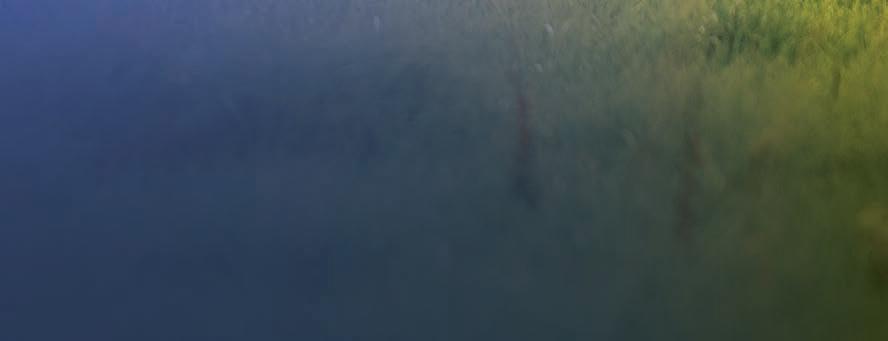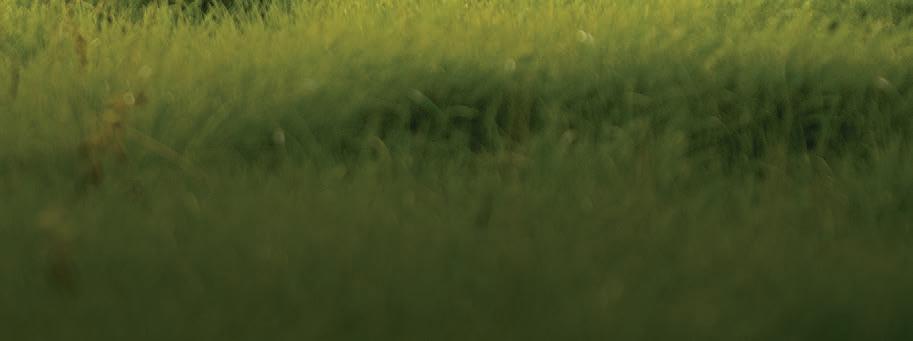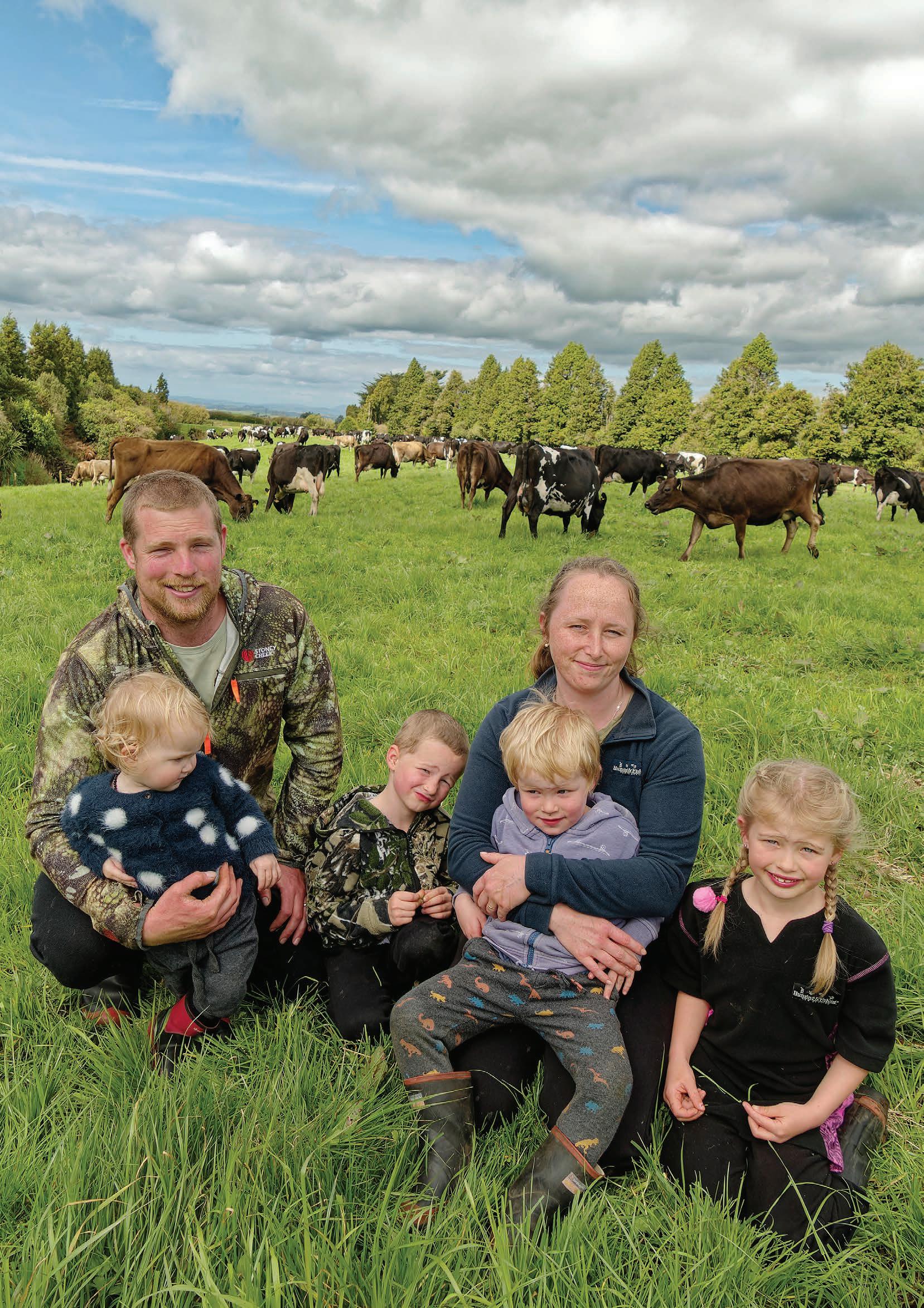
20 minute read
Standing their ground Taranaki couple did it tough
from Dairy Farmer November 2022
by AgriHQ
Standing their ground
Daniel and Rachel Simons have turned things around for themselves and their young family after a rough few years.
A couple with a love for hardy Ayrshire cattle had to work their way out of a financial squeeze.
When a Taranaki farming couple were told by their bank that there would be no more financial assistance, they could have thrown in the towel but instead turned to another bank for help. And now they’ve just bought a herd and become 50:50 sharemilkers.
Daniel and Rachel Simons are in their eighth season milking 400 cows on Rex and Janice Carroll’s 220ha farm at Midhirst.
Both hail from Taranaki. They have four children, Violet, 7, Stanley, 5, Lachlan, 3 and April, 1.
Daniel was born in Tauranga, where he lived in the family house bus and travelled around until he was five years old. He spent most of his early years near Dannevirke before the family moved to a coastal Taranaki farm when he was 14.
His mother became ill and Daniel left school to finish the last half of the season on the farm.
He moved to Bay of Plenty to work for the Animal Health Board undertaking Tb control. The job entailed trapping, and establishing how far and fast Tb was spreading. Having left school at the age of 14 without NCEA level 1, he has now completed NCEA levels 1 to 3 and recently completed an agribusiness financial management level 5 course.
Rachel grew up on her parent’s coastal Taranaki dairy farm and met Daniel at Okato’s Coastal Taranaki School. She pursued a graphic design degree. She had one year left to complete her degree and Daniel was driving to Taranaki every weekend to see her. They decided to get back into farming and look for a farm job to give them breathing space to ponder their future.
Their first job entailed one year working as farm assistants and two seasons contract-milking 300 cows before spending one season contractmilking 370 cows on a farm at Toko in central Taranaki.
There was no wiggle room in the budget for a worker so they got up at 3.30am every morning and didn’t finish work until 7pm. The couple wanted to start a family but knew that they couldn’t do so and maintain those punishing hours.
“This farm’s consultant told us that a good job was about to come up at the Carrolls. It hadn’t been advertised and he advised us to give Rex a call,” Daniel says.
“I phoned Rex who arrived at our place within half an hour. He told us that when you catch people on the hop they don’t have time to tidy up. We passed the test and were offered the job.”
The farm was running 340 cows when the contract was signed, and then the Carrolls bought the neighbouring farm, which pushed the herd number up to 450. They’ve now reduced the herd to 400 and keep some young stock on farm. The farm has a nearby 18ha runoff.
They worked as lower order sharemilkers for the first year when that season’s payout plummeted from the previous season’s record $8.50 to $3.90. It left them wondering whether they could recover from such a loss.
As soon as the payout dropped, their bank manager told them the bank couldn’t help them any longer and they’d have to ask the Carrolls for help with the costs.
“We told him that we’d just signed our contract and couldn’t do that. We’d take it on the chin and work our way out. We phoned another bank who agreed to help us. They put funds into our account and said that they’d sort it out
FARM FACTS
• Farm owners: Rex and Janice
Carroll • Sharemilkers: Daniel and Rachel
Simons • Location: Midhirst, Taranaki • Farm size: 220 hectares • Cows: 400 • Production target: 185,000kg
MS and an average 470kg
MS per cow
Continued page 10
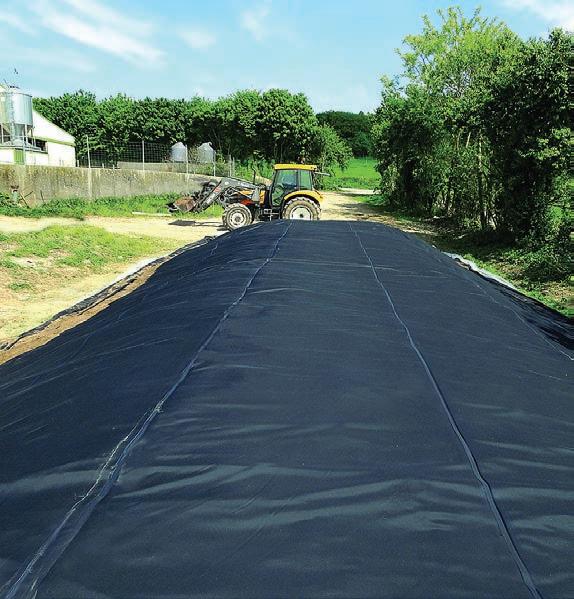
ECO SILAGE COVERS
• Highly resistant to damage and tearing • Labour and time saving – minimal tyres required • Reusable: guaranteed for 10 years, GeoSmart
EPDM greatly reduces the production of plastic waste
• Quick installation • Easy to repair • Environmentally friendly • Superior airtightness • Self-extinguishing
Contact us for more information 0800 109 093
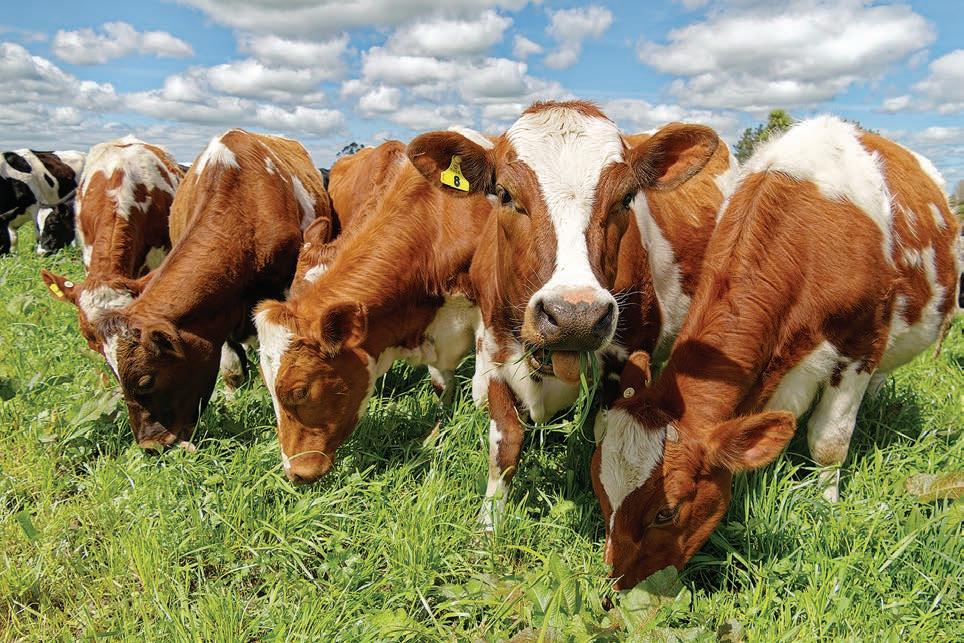
The Simons family run Mossy Ayrshires. Their love of Ayrshires came about when Daniel was out doing his AI run on a wet windy day and noticed the Ayrshires weren’t hiding from the weather.
Daniel Simons
after calving. They saved us and got us through our first season,” Daniel says.
They shifted to contract milking and were able to fix their financials over a two-year period.
Rachel says that their workers are worth their weight in gold and were a huge help in getting them back on their feet after the dramatic payout drop.
“When you’re in an extremely poor financial position, and have little kids, it would be so easy to throw in the towel. Having extremely good staff really brought back our passion for farming,” Rachel says.
“Poor staff ruin your mental health because you don’t want to go to work. Good staff give you time to do fun stuff, so you’re not always tied to the farm. You should never underestimate how fortunate you are to have good staff. They need a pat on the back too.”
Their love of Ayrshires came about when Daniel was out doing his AI run. He visited a farm that ran Jerseys and Ayrshires. It was a wet, windy, cold early November day and he noticed that the Jerseys were hiding from the weather under the trees but the Ayrshires weren’t hiding.
The Ayrshires were sitting and chewing their cuds in the middle of the paddock. One was eating rushes while standing in a deep puddle. He thought “Jingoes, that’s tough.” A year later he bought three Ayrshire calves.
They operate under their stud Mossy Ayrshires.
“Our stud, Mossy Ayrshires, is named after the farm Mossy Road Trust. That name comes from a book written in the 1920s by Frank S Anthony, titled Me and Gus, which contained stories about the people living on Mossy Road,” Rachel says.
“The character Gus was based on Rex’s father and Anthony was his neighbour. Mossy Road is the name he used for Denbigh Road so as not to make the characters identifiable.”
Ayrshires are strong animals that can thrive in more challenging farming regions. They’re great foragers and converters of feed to milk. This season there will be about 70 Ayrshire cows and heifers in the herd.
They like the Ayrshires for their temperament. Ayrshires once had a bad reputation for temperament, and some of that stigma prevails, but it’s now considered to be the dairy breed with the best temperament.
Their hardiness is also a bonus. Once, when Daniel wasn’t able to shift their calves until after lunch, the calves were bellowing at the gate waiting for their grass – except for the three Ayrshires who were standing by a post scraping off the lichen.
“They’d already eaten all of the moss off the rocks in the paddock. I immediately knew that I needed to get more of them,” Daniel says.

Introducing Easy Draft Automatic Drafting Made Easy
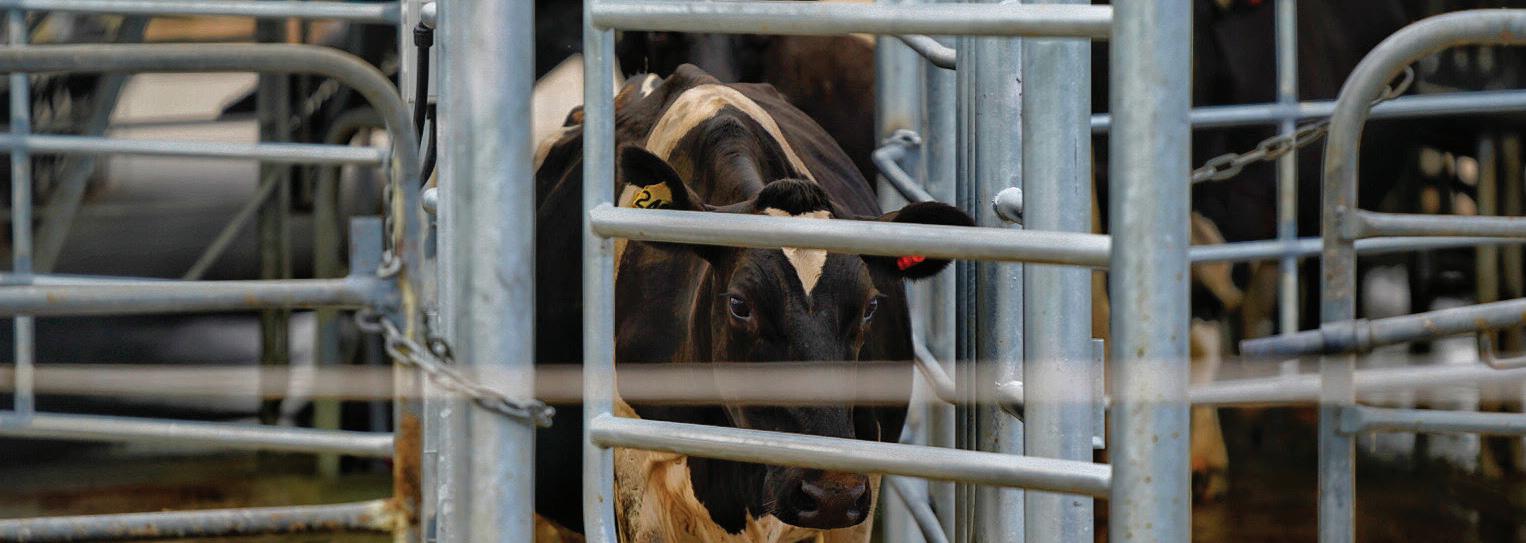
Easy Draft has been designed and refined over many years to be reliable, easy to use, gentle on animals and has seamless integration with CowManager.

Daniel left school at the age of 14 without NCEA level 1. He has now completed NCEA levels 1 to 3 and recently completed an agribusiness financial management level 5 course.
“One day last year we had 30cm of snow. I’d put the cows into a sheltered paddock and they stood along the fence waiting to be fed or shifted. The Ayrshires were leaning over the fence eating the thorny bush lawyer hanging from the trees.”
Ayrshires have often been overlooked due to their negative BWs. A high BW Ayrshire prior to their recent revaluation was zero.
“Some cows were negative 400BW, yet their production was on a par with crossbreds. They were undervalued. The bulls weigh out well and you can achieve great hybrid vigour using the Ayrshire for a three-way cross,” Daniel says.
The farm is 1.5km from the Egmont National Park boundary and is 457m above sea level. Many creeks cross the farm and there are areas of fencedoff native bush, swamps and riparian
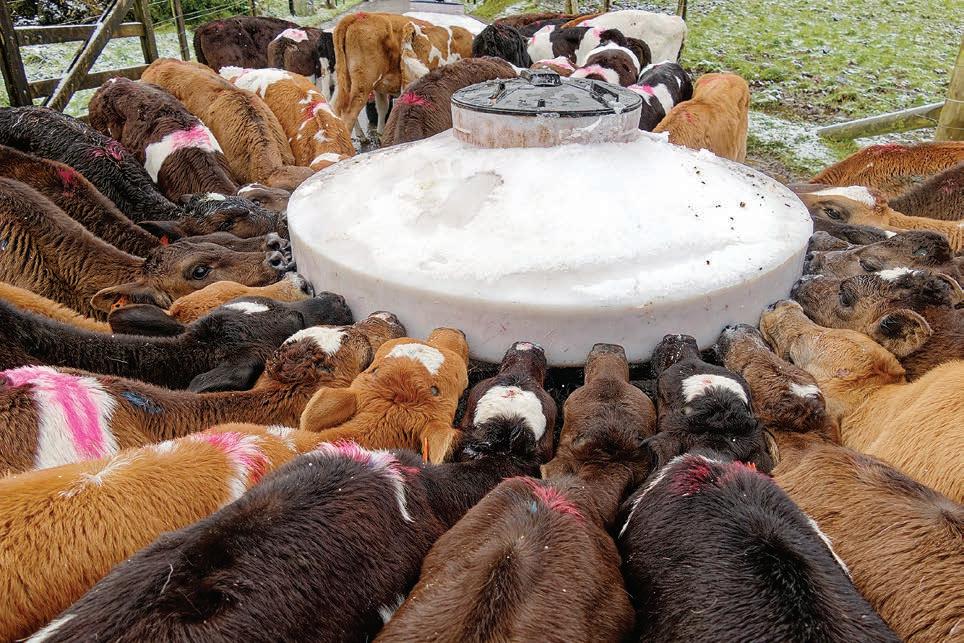
Calving begins August 7 and this season, 90 replacement calves have been kept. The calves tuck into breakfast. plantings. The farm has two large areas of QEII National Trust land and two wetlands.
The target production is 185,000kgs milksolids and an average 470kgs MS per cow on the system 2-3 farm.
“Ideally we’d do 500kg MS per cow, but we’d need 30 more days in our lactation. If we calve earlier we’d run out of grass. The grass stops growing at the end of May so if we go any later we’d run out before we even started. It’s a pretty fine balance.”
“I don’t care if a cow is 600kg or 350kg. If they both produce their bodyweight of MS, they’re good cows. Our most economical cows are the J9s. Some 420kg cows produce 500kg MS compared to some of the bigger 600kg F12 and F13 cows that produce 500kg MS,” Daniel says.
Daniel feels that this is a very good achievement considering they receive four metres of rain, snow and have a 260day lactation.
The farm uses a 40-day round and has a stocking rate of 2.2 cows per hectare. They try to keep the round as long as possible until the farm begins to grow plenty of grass. The farm has a 40-bail rotary shed with in-shed feeding and ACR. They feed 2.5-3kg of in-shed feed
Daughter April gets a bird’s eye view as she and Daniel check out the herd. The family are members of the Taranaki Ayrshire Club and have had some success showing their animals. Rachel and April with one of the kids’ show calves.
per day, mostly PKE with 10% tapioca to help bring it through the auger. This year they’ve dropped the PKE content to 60% and have added DDG and kibbled maize.
Thirty hectares of the farm and runoff is shut up for silage, which amounts to approximately 1000m3 of silage. This is about the maximum that can be utilised due to the rocks, trees or swamps in many of the paddocks.
They usually cut 400 bales of hay. Last year due to the drought, they weren’t able to make enough and had to buy hay and 80t of maize silage.
“Two years ago we trialled 7ha of turnips. We planted more last year, but when they’d got to 100mm we received 700mm of rain in 10 days. They drowned, and then the sun came out and cooked them,” Daniel says.
“About 20 plants survived. We ended up sowing some fast growing annual grass. Turnips aren’t worth the risk here; we can always buy hay or silage, or put extra feed through the cowshed if needed.”
The in-shed feeding has helped cow flow in and out of the shed and drastically reduced lameness because there is now no need to use the backing gate.
“Lameness was the first problem we tried to solve. I would’ve looked at 100 lame cows in the first year. This year I’ve looked at one foot so far, and last year I looked at four during the entire season,” Daniel says.
“We split the herd in two so that they fit in the yard easier, and have installed a footbath that’s used three days per week. Those changes have dramatically reduced lameness.”
This year they installed automatic cup removers and that has led to a drastic improvement in teat health. Last season’s SCC was around 180,000 and the ACR installation has dropped it by 40,000. The cups now come off as soon as the cows are finished milking, preventing teat damage due to over- or under-milking.
“ACR fixed our teat health issues and reduced mastitis in the herd. So far this season I’ve only had to treat nine cows.” Daniel says.
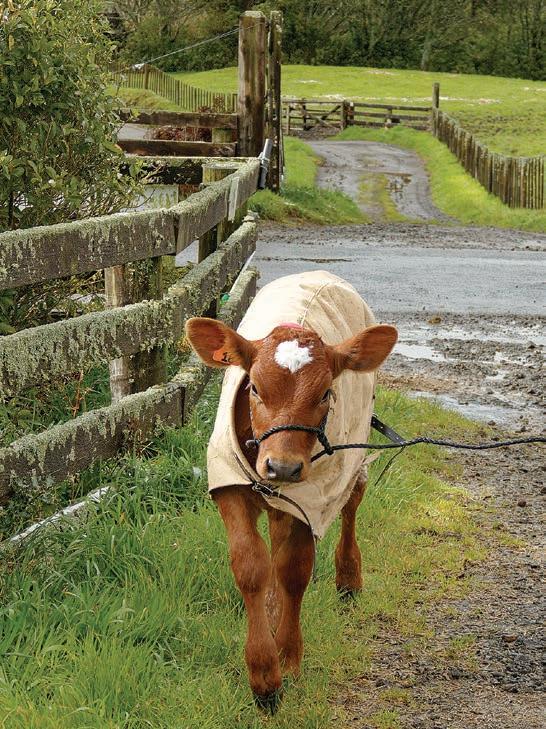
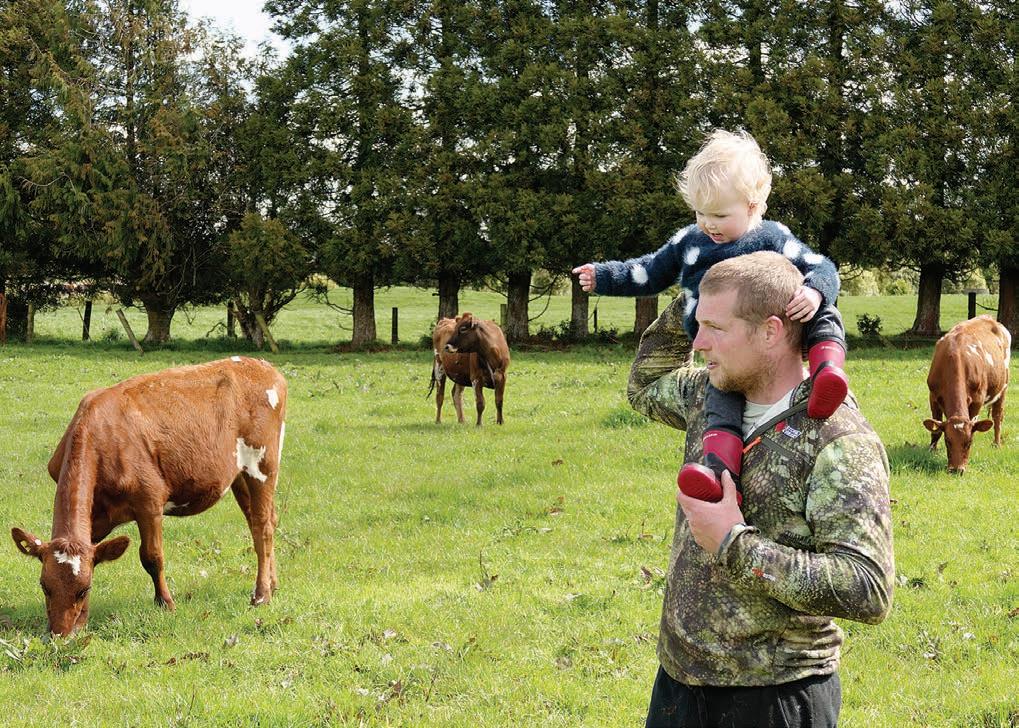
Round up the deals
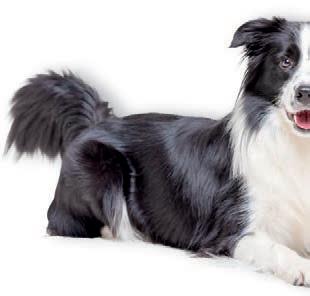
this Fieldays at our stand G55, G57 & G59 VISIT AND YOU COULD WIN A BOSCH PRIZE PACK!*
We’ve rounded up these great brands in one place.
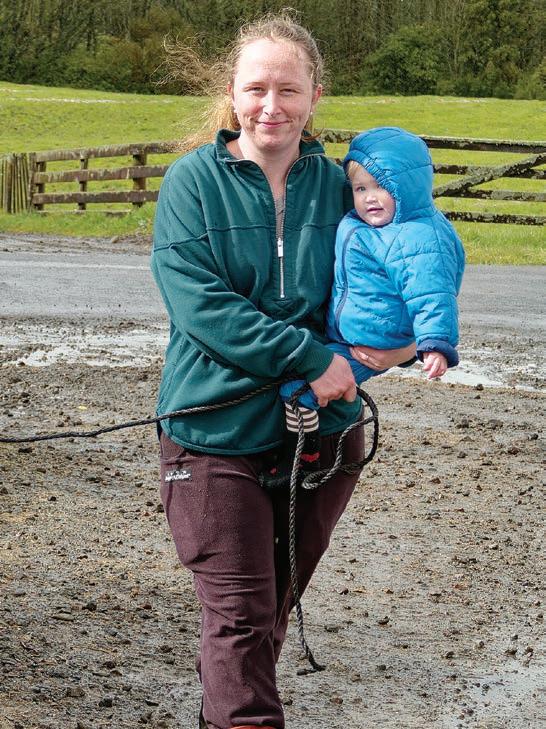
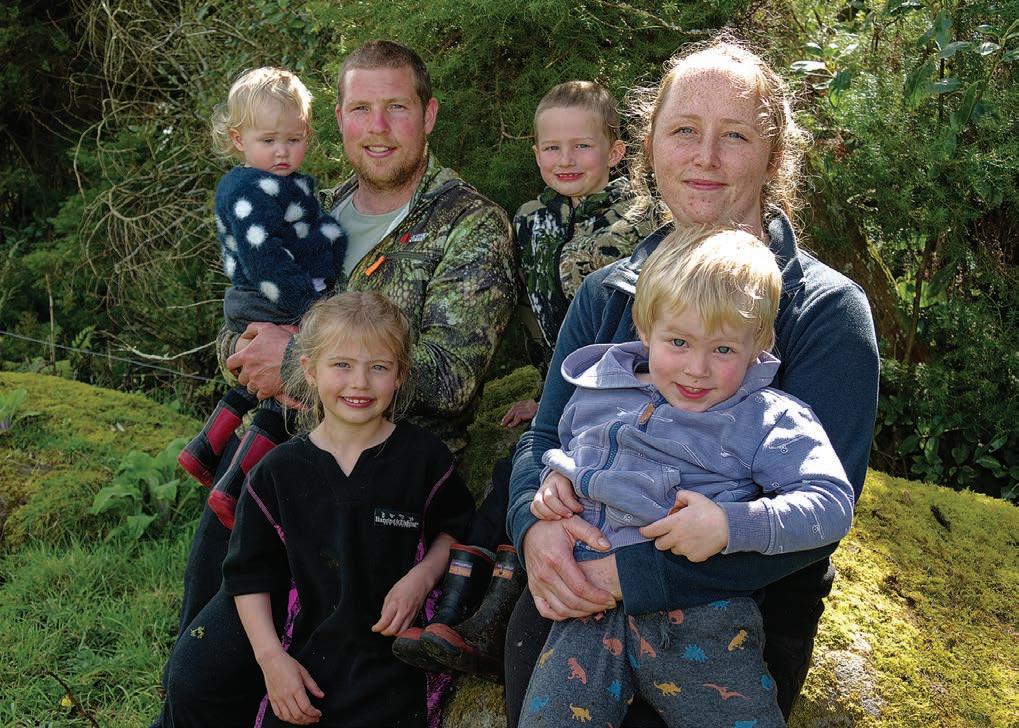
The Simons family get out on farm together as often as they can. Daniel with April, Stanley and Violet, and Rachel with Lachlan.
This season they decided to attempt to reduce penicillin usage, so bought a Mastatest system. So far, they’ve tested 13 cows and it’s told them that three cows needed no treatment. They feel that the system will pay for itself in the first season.
One hundred cows are wintered on the runoff for around 70 days before returning to the farm to calve. The young stock are sent there if needed.
Calving begins August 7 and they only keep calves out of cows that have produced around their bodyweight of MS.
The calves are kept on the farm until May when 40 go out to grazing; the other 40-50 stay on the farm. Daniel likes to use some of the more distant paddocks as an “on-farm runoff” for them and leave the closer paddocks for the cows. If the calves start catching up to the grass they’re moved to the runoff.
Usually, 75-80 replacements are raised, but this year they’ve decided to raise 90. The calves are collected daily unless the weather is poor, when they are collected twice daily. They receive their first drink of warm gold colostrum within an hour of arriving in the shed.
The calves receive three feeds of colostrum before going onto one feed per day as well as ad-lib meal and hay. This year they’re using milk powder for the first time.
The bigger crossbred calves are weaned at 100kg and the smaller calves at 90-95kg. They have access to the paddock from the shed after two to three days and can come and go as they please.
Last year’s 91.5% in-calf rate was the highest for four years. The six week in-calf rate is always 75%-80%. The farm used
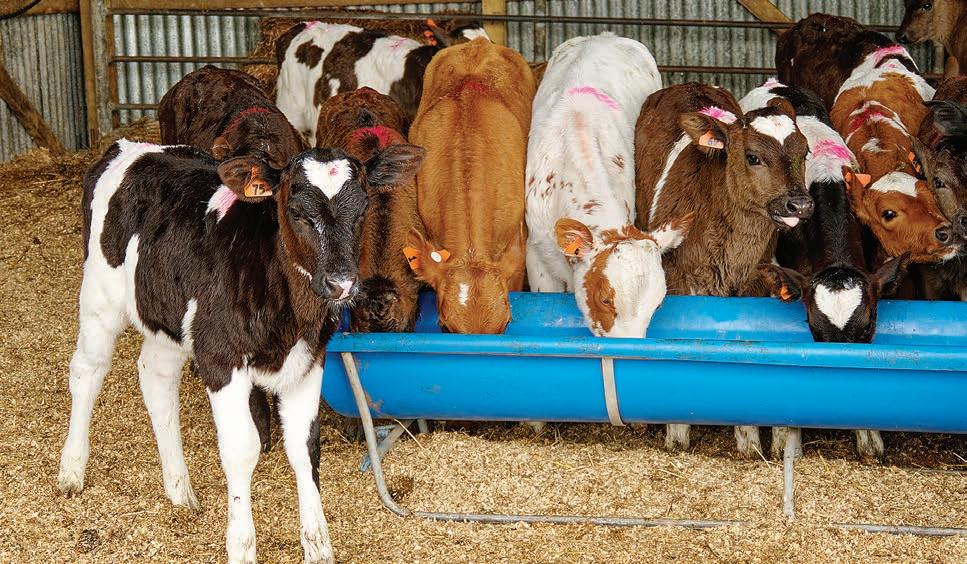
Last year’s 91.5% in-calf rate was the highest the Simons family has achieved for four years. to run bulls and had an 85%-86% in-calf rate. Daniel thinks the bulls became bored, started scrapping and stopped doing their job.
The in-calf rate went from 85% to 94% in the first year of solely using AI, tail paint and scratchies. At first Daniel thought it was a fluke but the next year’s was 93%.
“If you breed for good fertility and cull the empty cows then that’s exactly what you get. We have used CIDRs and synchronicity programmes, but I feel they were part of the reason for our poor in-calf rate,” he says.
“I think CIDRs may mess with their hormones. They cycle to the programme, and go quiet and don’t cycle again. They now hold better, which gives us a better six week in-calf rate. We often had days when 30 cows would calve. Now we get 10-12 per day, every day.”
Their goal of herd ownership began by rearing five recorded heifer calves that the Carrolls didn’t want. The Simonses reared them, sent them to grazing and sold them as in-calf heifers, and then bought 12 weaner heifers.
“The Carrolls sold stock to allow us to bring in stock. Getting to 50:50 sharemilking is such a big ladder to climb, but the Carrolls allowed us to get a foot in the door and helped us achieve that goal. We couldn’t have done it so fast without their help,” Rachel says.
They grazed those heifers off farm, artificially inseminated them and raised their calves on milk powder so it wouldn’t cost the Carrolls anything.
“We leased out those 25 heifers and
Daniel Simons
reared another 25 the following season. The next year we sold the leased cows and the in-calf heifers and bought more calves,” Daniel says.
“By doing that we were able to bring 70 heifers into the herd, have 40 yearlings out grazing and rear 40 calves. We didn’t get to 50:50 by saving a lot of money. We did it by buying five calves, selling them and buying 10, and then selling them and buying 20.”
Mating is solely AI for the 13-week mating period which begins at the end of October or the first week of November. They only use nominated sires and this year are using nine different bulls and approximately two thirds will be Jerseys. The remainder will be Friesian and Charolais. The heifers will be put to AI for six weeks before putting a Jersey bull out with them.
Sexed semen will be used over the top 100 cows, and yearlings. The bottom 50% will go to beef to reduce bobby numbers. All heifer calves will be reared because they will be from their best cows.
“Sexed semen is used on our best cows, the rest go to beef bulls. We use beef bulls from the first week because they have a longer gestation and push calving back by five days. We’ll use short gestation bulls at the other end to bring calving forward by two weeks and give us a 10-week calving period,” Daniel says.
The first attribute they look for is capacity followed by rump width, udders and production. The herd has been bred to nominated bulls with good capacity and longevity for around 40 years. Daniel’s favourite cows are those over 10 years old. He knows that if they’ve lasted that long in the farm’s challenging climate, they’re very good cows. They have 110 cows that are eight years old and over.
“If a 13-year-old cow can do the same production as a heifer, why bring in another heifer? That cow’s done the hard yards and made money for 10 years. As long as she does better than a heifer, she can stay in the herd,” he says.
Their best Ayrshire cows are usually flushed for embryos and put into the yearlings. Last year’s hold rate wasn’t as good as they’d hoped for, so they’re holding their breath for this year’s results.
“We use ET [embryo transfer] to build up our good Ayrshire families and there are a couple of old cows that we don’t have any daughters from. Some are topproducing cows, others are good show cows that we want daughters from. If a cow is from a good family, has high production and looks good enough to show, then she’s worth flushing,” Daniel says.
They like their show animals and look forward to preparing their cows for showing and have become hooked on the event.
“The Taranaki Ayrshire Club are a great bunch of people.
“We have monthly walks of member’s farms. It gets you off the farm and socialising. Everyone helps each other out and there’s an incredible amount of encouragement given to newcomers,” Rachel says.
“Showing gets you out of the house and off the farm. When you’re showing, practice makes perfect. You’ve got to walk them, tie them up, and get them used to being in another environment, being around strangers, and fuss over them a bit.”
They took three calves to their first show and one placed second. They then took two calves to the A&P Show and won North Island Champion Junior Calf. The following year they won the twoyear-old class at the Royal Show.
Daniel and Rachel are firm believers in
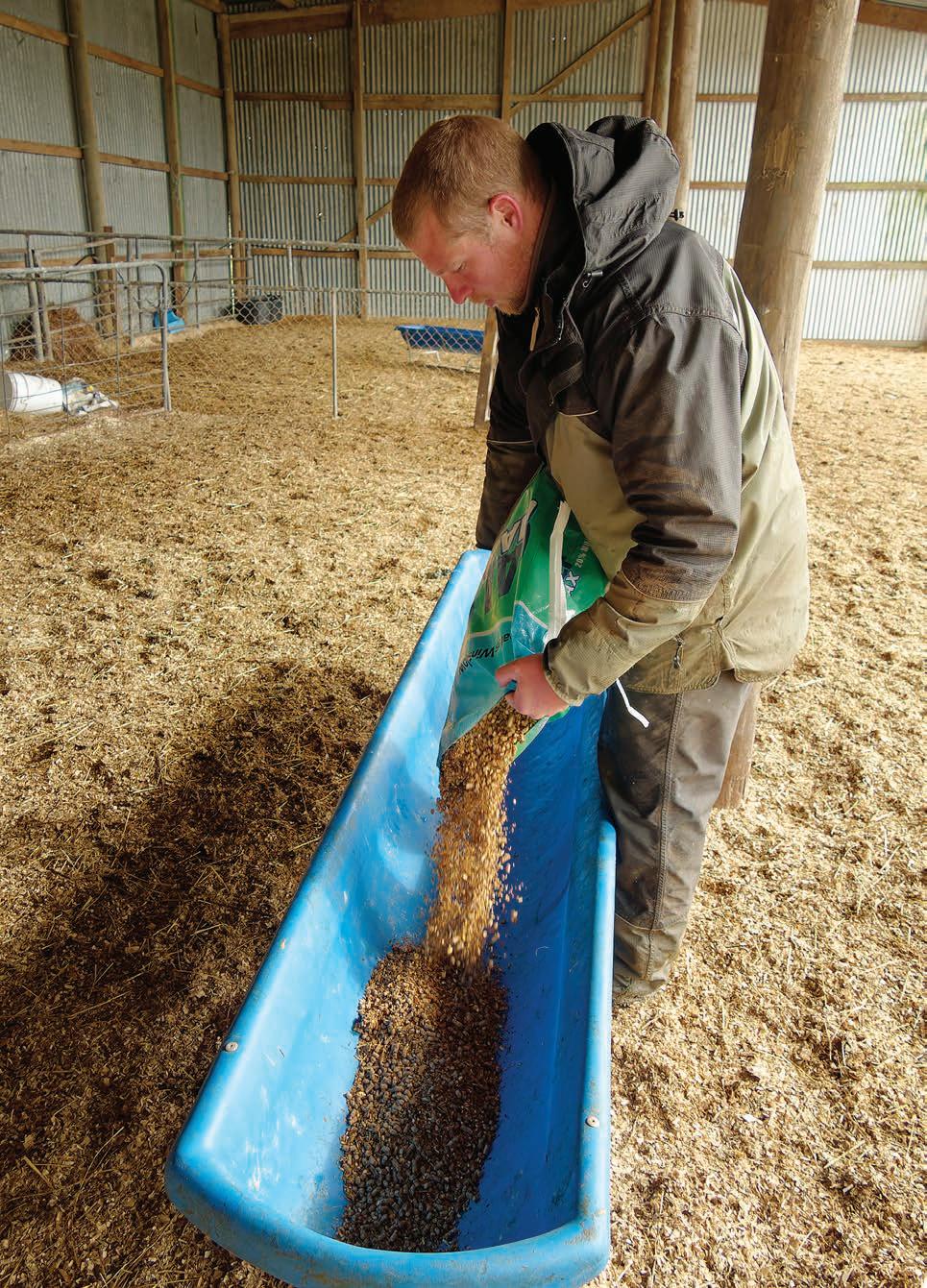
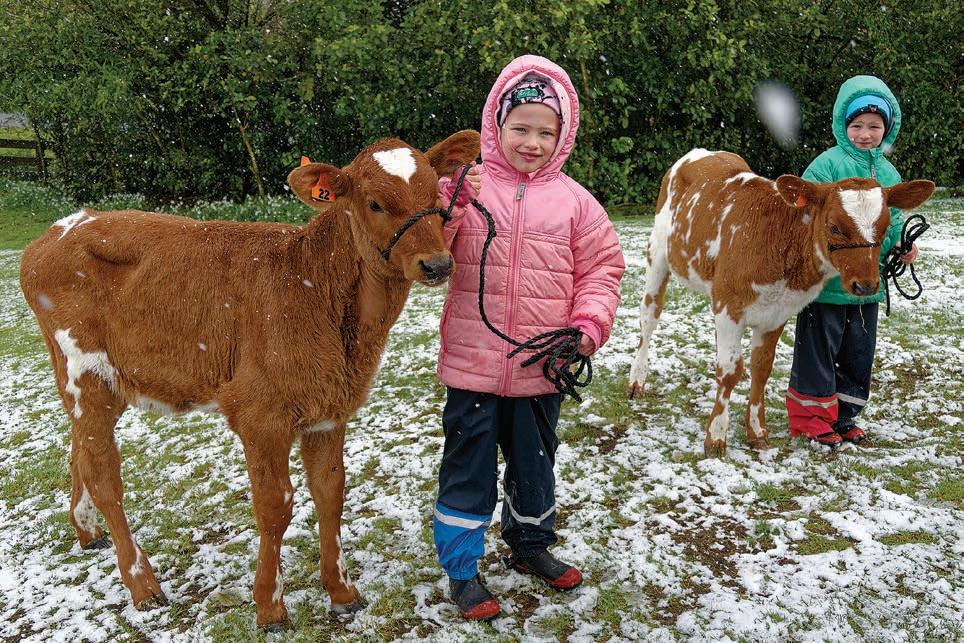
The children have been getting involved in showing the calves and practise with them even when it is snowing. Violet and Stanley with their show calves.
giving everyone on the farm reasonable hours to provide a better working environment. The farm has two staff who work 11 days on and three off. This allows them to have alternate weekends off.
Daniel milks in the mornings until 6am, which allows their staff to start at 6am rather than having to get up at 4am.
He gets up at 4am, sets up the shed and milks the first herd. Their 2IC arrives at 6am to bring in and milk the second herd. During calving their 2IC starts at 4.30am to bring in the herd while Daniel checks the springers.
“Now that’s over they start work at 6 or 7am for the rest of the season so no one gets too tired or burnt out. After Christmas we are hoping our staff can start at 7am and finish a bit earlier in the afternoon,” Daniel says.
“I love milking in the morning. I don’t like being in the shed if the sun’s up. I’d do it but I’d rather be working outside. I can take the kids with me and we can all go out on the farm together.”
When they get time off they tend to visit other farms. Daniel does a lot of hunting, fishing and camping with the kids.
“As a family, we haven’t been on a holiday since the kids were born. The kids enjoy the outdoors. It’s nice when there’s a fine weekend and we ask them what they want to do and they want to go tramping, fishing, hunting or camping,” Daniel says.
“It’d be nice to think that in 10 years we could be in a situation where we’ve paid off the cows and in a position to maybe purchase the farm.” n



Beef Up Your Your Bottom Line Line




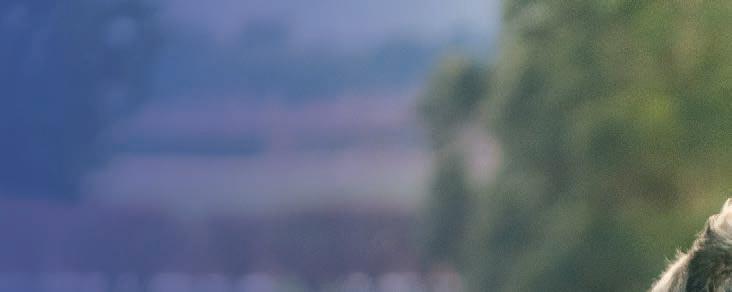
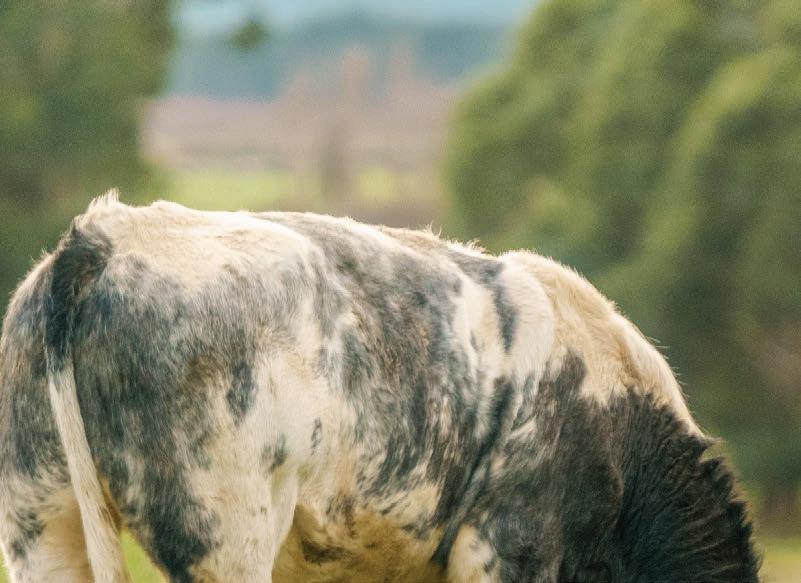

Short Gestation Belgian Blue is the #1 Dairy Beef Solution
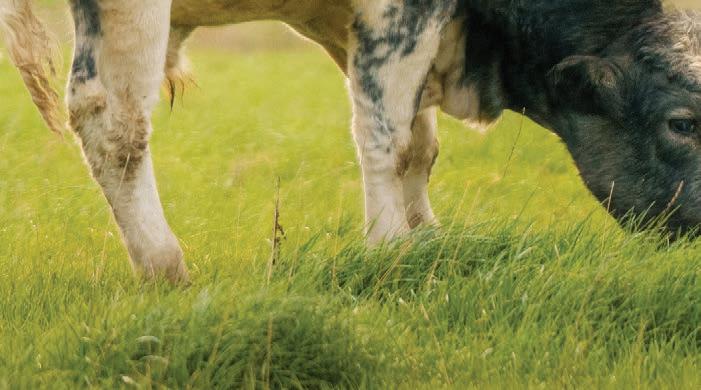
With sought-after offspring, you gain valuable days in milk, easy calving, a tighter calving period, easy-to-rear calves and a second income stream from the offspring.
